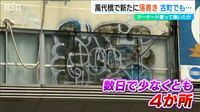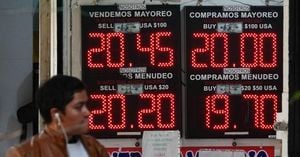In a troubling turn of events for Niigata’s cultural heritage, new graffiti has been discovered on the iconic Bandai Bridge, a symbol of the city and a nationally designated Important Cultural Property. This marks the third instance of graffiti being found on this historic structure.
Located over the Shinano River, Japan's longest river, the Bandai Bridge is cherished by locals. According to reports, on March 21, 2025, new graffiti was found approximately 20 meters away from previously confirmed graffiti on the bridge, raising eyebrows and sparking conversations about public property and its protection. The latest tag appears to have been written with a white pen, leaving both beauty and integrity questioned in this cherished locale.
Not limited to the Bandai Bridge, similar graffiti has surfaced in the area, including on the downstream Yanagito Ohashi bridge and in various private facilities nearby. Furthermore, concern deepens as residents reported at least four different locations in the bustling downtown area known as Furumachi have also been vandalized with graffiti.
In Furumachi, which is about 600 meters away from Bandai Bridge, graffiti has been discovered written at significant heights on the arcade structures there. A local resident expressed astonishment, saying, "This is quite unprecedented to see graffiti done in such a public arcade," indicating the unusual nature of such acts. Intriguingly, some of the graffiti in this district features strange patterns resembling the numbers '25' and '26', leaving residents speculating about the motives behind these scribbles.
Reflecting on the motivations behind these actions, a local resident pondered, "I wonder if expressing oneself this way is the right approach?" These sentiments resonate among community members who feel this form of expression may not honor their city’s symbols and history. The presence of graffiti at such public venues raises concerns about how personal expressions can negatively impact public spaces and cultural landmarks.
The Niigata National Highway Office, responsible for managing both the Bandai Bridge and Yanagito Ohashi bridge, is not taking these events lightly. They announced plans to file a damage report with the police, a move that underscores the seriousness of the situation. Local authorities are now faced with balancing the right to free expression and the need to preserve cultural heritage.
While graffiti often signifies rebellious self-expression, the instances in Niigata highlight a significant clash between such freedom and the preservation of historical integrity in public spaces. As discussions continue, these emerging acts of graffiti may prompt deeper inquiries into preventive measures for protecting public landmarks while accommodating the expressions of the younger generations.
The townspeople continue to share their observations, sharing snippets of discontent over the mixing of art with vandalism, arguing that expressing creativity should be appreciated but within appropriate contexts. As the issue escalates, how the local government will navigate these complexities remains to be seen.
As Niigata grapples with this unsettling trend, the community's reputation as custodians of their cultural heritage is under scrutiny. Will this wave of graffiti serve as a catalyst for change in how such expressions are viewed and managed in public spaces? Time will tell as Niigata City and its residents confront these new challenges.




